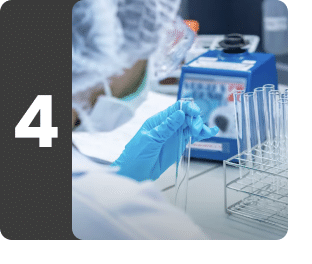Vitamin D (25-Hydroxy)
Understanding Vitamin D (25-Hydroxy)
What is Vitamin D (25-Hydroxy)?
The Vitamin D (25-Hydroxy) test measures the level of 25-OH vitamin D in the body. Vitamin D helps your body absorb calcium and phosphorus, which are important for strong bones and teeth. It also supports your immune system. This test helps you assess bone health, immunity, and overall well-being.
Vitamin D is an essential fat-soluble nutrient. It exists in two primary forms:
- Vitamin D3 (Cholecalciferol): derived from animal sources, supplements, and made by the skin when you are in sunlight.
- Vitamin D2 (Ergocalciferol): derived from plant sources and supplements.
Both vitamin D2 and D3 perform similar functions. Both forms are converted into 25-hydroxy vitamin D D2 or D3 respectively in the liver. The Vitamin D (25-Hydroxy) test checks the total amount of vitamin D in your blood (D2 + D3), but it doesn’t distinguish between the two types.
As per an NCBI (National Center for Biotechnology Information) study, vitamin D deficiency is highly prevalent across all age groups in India. Insufficient vitamin D levels can increase susceptibility to the following conditions:
- Fractures
- Weakened muscles
- Fatigue
- Compromised immune function
- Higher likelihood of chronic illnesses like diabetes
The Vitamin D (25-Hydroxy) test is done to check if you have health problems that affect how your body uses vitamin D, such as weak bones (osteoporosis), or kidney or liver issues. It is also done if there are risk factors like insufficient sunlight exposure or having a poor diet. It is also used for the diagnosis of causes of rickets and osteomalacia. Additionally, this test is done to monitor vitamin D levels in people who are taking supplements, to ensure their levels stay within a healthy range and are not too low or too high.
Usually, no special preparation is required for this test. You can get this test at any time of the day at your convenience. However, it is generally recommended to stop taking vitamin D supplements before the Vitamin D (25-Hydroxy) test, as these supplements may affect the accuracy of the test results.
Always consult your doctor to understand what your results mean. They can guide you with the right treatment, lifestyle changes, or medication if needed.
Lifestyle Tips to Support Healthy Vitamin D Levels:
☀️ Heliotherapy (Sunlight Exposure): Spend some time outdoors, under the sun (preferably in the morning) to help your body naturally produce vitamin D.
🥙 Eat (Diet): Include vitamin D-rich foods such as eggs, mushrooms, salmon, fortified milk, and orange juice.
🏃 Activity (Exercise): Engage in regular physical activity, especially outdoors, can support better vitamin D synthesis and bone health.
😓 Lifestyle (Stress): Manage stress through relaxation techniques or yoga, as stress can indirectly impact bone health.
👨⚕️ Talk to Your Doctor (Consultation): Avoid self-medication and taking high doses of vitamin D supplements without a doctor's advice.
🚭 Habits (Alcohol & Smoking): Limit alcohol and quit smoking, as these can affect vitamin D metabolism and bone strength.
What is Vitamin D (25-Hydroxy) used for?
The Vitamin D (25-Hydroxy) test can be done:
A. In Symptomatic Individuals
- Bone or joint pain
- Chronic fatigue
- Muscle weakness or cramps
- Susceptibility to frequent infections
B. In High-Risk Groups
- Osteoporosis or other bone disorders
- Inflammatory bowel disease
- Malabsorption syndromes (e.g., celiac disease, Crohn’s)
- Chronic kidney or liver diseases
C. In Special Population
- Pregnant and lactating women
- Elderly individuals
- Infants receiving exclusive breastfeeding
D. In Individuals With Lifestyle-Related Risks
- Limited sun exposure
- Strict vegan diet
- Obesity
What does Vitamin D (25-Hydroxy) measure?
The Vitamin D (25-Hydroxy) test measures the levels of vitamin D in the body. Vitamin D is an essential nutrient that can be synthesized in the body upon healthy exposure to sunlight or absorbed from dietary sources. It majorly exists in two forms: vitamin D2 (ergocalciferol) and vitamin D3 (cholecalciferol). Vitamin D2 is present in plants, such as yeast or mushrooms, and is available as a supplement in fortified foods, and vitamin D3 is found in foods like cheese, green vegetables, mushrooms, egg yolks, and fatty fish.
Vitamin D is available in two key forms: D2 (present in plants like mushrooms and in some fortified foods) and D3 (present in foods like cheese, green vegetables, egg yolks, mushrooms, and fatty fish).
Both forms of vitamin D need to be converted in the liver and kidneys before the body can use them effectively. This test shows the total level of vitamin D (D2 + D3) circulating in the body and guides your doctor in recommending the right treatment or lifestyle changes if needed.
Interpreting Vitamin D (25-Hydroxy) results
Interpretations
A lower vitamin D level than the normal reference range indicates vitamin D deficiency, which can be because of less sun exposure, dietary lack, or decreased absorption from the intestine.
A higher vitamin D level than the normal reference range indicates vitamin D intoxication, usually due to excess vitamin supplementation.
Range:
The vitamin D range is measured as nanograms per milliliter (ng/mL) or nmol/L and can vary from lab to lab.
|
Level |
Reference range (ng/mL) |
|
Deficiency |
<20 |
|
Insufficiency |
20-29 |
|
Sufficiency |
30-100 |
|
Toxicity |
>100 |
Note:
- This test does not include a separate vitamin D2 and D3 level analysis.
- There can be seasonal variation in 25 (OH) vitamin D levels, with values being 40-50% lower in winter than in summer. It is also influenced by sunlight, latitude, skin pigmentation, sunscreen use, and hepatic function.
- 25 (OH) vitamin D levels can vary with age.
- 25 (OH) vitamin D level is increased during pregnancy.
Answers to Patient Concerns & Frequently Asked Questions (FAQs) about Vitamin D (25-Hydroxy)
Frequently Asked Questions about Vitamin D (25-Hydroxy)
Q. What is the Vitamin D (25-Hydroxy) test used for?
Q. What are the signs and symptoms of low vitamin D levels?
Q. How much vitamin D is needed daily?
Q. What are the causes of vitamin D deficiency?
Q. What is the right time to get the Vitamin D (25-Hydroxy) test done?
Q. Are there any risks associated with the Vitamin D (25-Hydroxy) test?
Q. Who should be tested for vitamin D?
Q. What are some of the common vitamin D benefits for the body?
Q. Which vegetarian foods are rich in vitamin D?
Q. What are the additional lab tests needed to be performed along with the vitamin D test?
Q. What are the common side effects of vitamin D overdose?
Q. What is osteomalacia?
Q. What is osteoporosis?
Q. Is there any correlation between the nutrients vitamin D and calcium?
Book a Vitamin D (25-Hydroxy) test at home near me





Other tests









